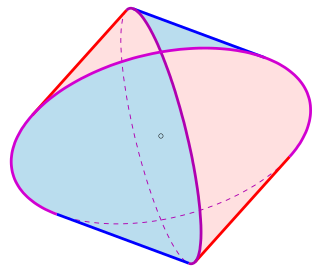
In mathematics, the slope or gradient of a line is a number that describes both the direction and the steepness of the line. Slope is often denoted by the letter m; there is no clear answer to the question why the letter m is used for slope, but its earliest use in English appears in O'Brien (1844) who wrote the equation of a straight line as "y = mx + b" and it can also be found in Todhunter (1888) who wrote it as "y = mx + c".

Wade–Giles is a romanization system for Mandarin Chinese. It developed from a system produced by Thomas Francis Wade, during the mid-19th century, and was given completed form with Herbert A. Giles's Chinese–English Dictionary of 1892.

The grade (US) or gradient (UK) of a physical feature, landform or constructed line refers to the tangent of the angle of that surface to the horizontal. It is a special case of the slope, where zero indicates horizontality. A larger number indicates higher or steeper degree of "tilt". Often slope is calculated as a ratio of "rise" to "run", or as a fraction in which run is the horizontal distance and rise is the vertical distance.

The Human Development Index (HDI) is a statistical composite index of life expectancy, education, and per capita income indicators, which is used to rank countries into four tiers of human development. A country scores a higher level of HDI when the lifespan is higher, the education level is higher, and the gross national income GNI (PPP) per capita is higher. It was developed by Pakistani economist Mahbub ul-Haq and was further used to measure a country's development by the United Nations Development Programme (UNDP)'s Human Development Report Office.

In combinatorics, a branch of mathematics, the inclusion–exclusion principle is a counting technique which generalizes the familiar method of obtaining the number of elements in the union of two finite sets; symbolically expressed as
In sports, a winning percentage is the fraction of games or matches a team or individual has won. The statistic is commonly used in standings or rankings to compare teams or individuals. It is defined as wins divided by the total number of matches played. A draw counts as a 1⁄2 win.

The Nationwide Unified Examination for Admissions to General Universities and Colleges (普通高等学校招生全国统一考试), commonly abbreviated as Gaokao, is the national undergraduate admission exam of China, held in early June every year. The exam is held by provincial governments under the Ministry of Education's orders and is required for undergraduate admissions to all higher education institutions in the country. The exam is taken by high schools' graduating seniors at the end of their final year.
Germany uses a 5- or 6-point grading scale (GPA) to evaluate academic performance for the youngest to the oldest students. Grades vary from 1 to 5. In the final classes of German Gymnasium schools that prepare for university studies, a point system is used with 15 points being the best grade and 0 points the worst. The percentage causing the grade can vary from teacher to teacher.
Academic grading in India is based on a percentage system and they are called GPA or www

In geometry, a Steinmetz solid is the solid body obtained as the intersection of two or three cylinders of equal radius at right angles. Each of the curves of the intersection of two cylinders is an ellipse.
Academic grading in Mexico employs a decimal system, from 0 to 10, to measure the students' scores. The grades are:
Singapore's grading system in schools is differentiated by the existence of many types of institutions with different education foci and systems. The grading systems that are used at Primary, Secondary, and Junior College levels are the most fundamental to the local education system,
Fourier–Motzkin elimination, also known as the FME method, is a mathematical algorithm for eliminating variables from a system of linear inequalities. It can output real solutions.
In mathematical logic, monoidal t-norm based logic, the logic of left-continuous t-norms, is one of the t-norm fuzzy logics. It belongs to the broader class of substructural logics, or logics of residuated lattices; it extends the logic of commutative bounded integral residuated lattices by the axiom of prelinearity.
Academic grading systems in Australia include:

Standard Zhuang is the official standardized form of the Zhuang languages, which are a branch of the Northern Tai languages. Its pronunciation is based on that of the Yongbei Zhuang dialect of Shuangqiao Town in Wuming District, Guangxi with some influence from Fuliang, also in Wuming District, while its vocabulary is based mainly on northern dialects. The official standard covers both spoken and written Zhuang. It is the national standard of the Zhuang languages, though in Yunnan a local standard is used.

"Beijing" is from pinyin Běijīng, which is romanized from 北京, the Chinese name for this city. The pinyin system of transliteration was approved by the Chinese government in 1958, but little used until 1979. It was gradually adopted by various news organizations, governments, and international agencies over the next decade.
Japhug is a Gyalrong language spoken in Barkam County, Rngaba, Sichuan, China, in the three townships of Gdong-brgyad, Gsar-rdzong and Da-tshang.
This is a list of grading systems used by countries of the world, primarily within the fields of secondary education and university education, organized by continent with links to specifics in numerous entries.
Gadolinium(III) fluoride is an inorganic compound with a chemical formula GdF3.











